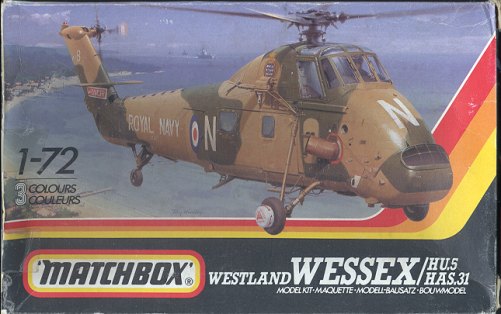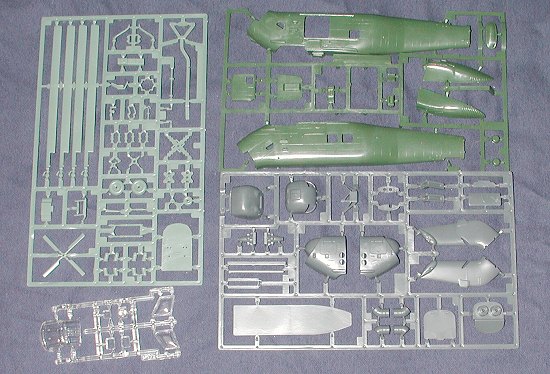
| KIT: | Matchbox 1/72 Westland Wessex |
| KIT # | PK 133 |
| PRICE: | $10.00 when new |
| DECALS: | 2 options |
| REVIEWER: | |
| NOTES: |

| HISTORY |
All other Wessex variants have two coupled Gnome engines in place of the single Gazelle. These include the RAF's HC Mk.2, flown for the first time in production form on 5 October 1962 and entering service with No.38 Group in February 1964; the Navy's HU Mk.5, for which two orders have been placed and which entered service in summer 1964 as a commando-carrier assault transport; twelve Mk.52's for the Iraqi Air Force, three Mk.53's for the Ghana Air Force, and one Mk.54 for the Brunei government. Seven Wessex Mk.60's have been built for Bristow Helicopters Ltd. These are 10-passenger commercial equivalents of the Mk.2 and operate in support of the oil and gas drilling rigs in the North Sea. The Wessex is now all but gone from British military service with the last unit operating them being 60 Sq in Northern Ireland.
| THE KIT |

Matchbox's kit of the Wessex is typical of the later kits produced before they stopped producing new kits and were bought by Revell AG. In several colors of plastic, the kit really is rather complex. It is of the raised panel line variety and you do have to be careful of ejector pin marks and of the usual sink areas in thick pieces and where there are alignment pins. The clear bits are rather thick, but nothing atypical of Matchbox.
Though there is no cabin detail, the adventurous modeler can install what he feels needed as the cabin door is a separate piece and can be displayed open. The cockpit is equally Spartan and like most helo kits is missing the left hand control that determines engine speed and blade pitch (Collective). The rotor head is sufficiently complex enough to suit most of us. For some odd reason, the tail section is molded separately. I guess that is to give those of us who want to fold it over a head start.
The kit builds into either an HU.5 or HAS.31, the big difference between the two being the forward section of the helo. Instructions are probably typical Matchbox in that the color info is in a separate section of the instructions and the color info is generic. I'd also like to tell you about the decals, but you see, this kit has neither. It is one of those swap meet kits that I didn't thoroughly check before leaving. Fortunately, when one has done a lot of models, instructions are not always necessary, though they would be nice. As for decals, Modeldecal did at least two sheets of Wessex' so there are oodles of markings available.
| CONCLUSIONS |
I have built this kit, though it has been nearly 20 years ago and had little trouble with it. I did break several of the very fine pieces when trying to remove them from the sprue, so next time will use a razor saw and be very careful about it! It is not a difficult kit, though a touch time consuming as it does have those fragile pieces I mentioned. Though undoubtedly outclassed by the newer Italeri kit, it should still make into a fine representation with a bit of extra work and perhaps a brass detail set to help!
If you would like your product reviewed fairly and fairly quickly by asite that has over 200,000 visitors a month, please contactme or see other details in the